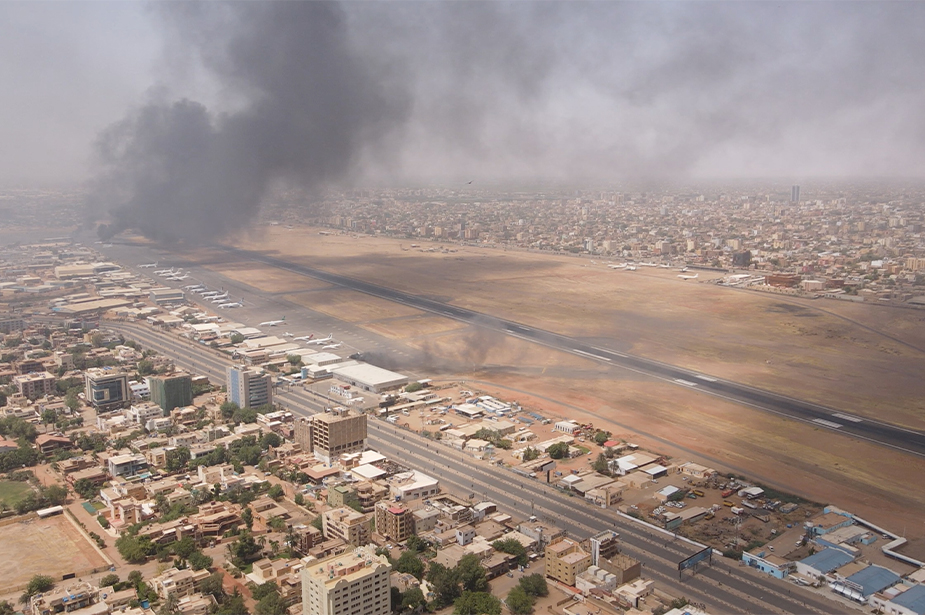
ISIS-K is among several terrorist outfits in Afghanistan, each with its own relationship with the Taliban
Daesh claimed responsibility for Aug. 26 bombings that killed 13 US soldiers and some 170 Afghan civilians
LONDON/CAIRO: Only three months after the deadly attacks on New York and Washington in 2001, Osama bin Laden and a small band of followers were forced to flee Tora Bora in the mountainous east of Afghanistan as US special forces and their local allies closed in.
The Al-Qaeda leader had been in Afghanistan for five years when he oversaw the 9/11 bombings, which killed nearly 3,000 people in the US. In 1996, Bin Laden had been given protection in the country by the first Taliban regime of Mullah Omar.
ad
Since the days of the first holy war against the Soviet Union, he had been responsible for training and arming thousands of Arab recruits in war-torn Afghanistan.
A frame grab (L) taken 29 October 2004 from a videotape aired by Al-Jazeera news channel shows Al-Qaeda leader Osama bin Laden. (File/AFP)
Nearly 20 years on and under new Taliban leaders, Afghanistan remains a haven for terrorists from Central Asia and the Middle East in the form of Al-Qaeda and Daesh. Since the Taliban seized power in mid-August, hopes and promises for a newer, more peaceable Afghanistan have proved illusory.
Ads by optAd360
On Aug. 26, Islamic State Khorasan Province (ISIS-K) claimed responsibility for twin bombings targeting US service personnel and Afghan civilians in and around Kabul airport. In the chaos and confusion, Daesh and its competitor, Al-Qaeda, have scented new opportunities, much as Bin Laden did two decades ago.
A UN sanctions monitoring team reporting in June found that a significant part of the Al-Qaeda leadership was based in the region along the Afghanistan-Pakistan border and that ISIS-K “remains active and dangerous.” ISIS-K is the most violent of all the groups.
An Afghan security personnel inspects a residential house that was damaged in a gunbattle between security forces and Islamic State (IS) group fighters in Jalalabad on February 15, 2021. (File/AFP)
Ads by optAd360
Although badly mauled by US forces and those of the old Afghan government, its ability to attract and motivate fighters from around the world make it feared from Moscow to Beijing, Tashkent to Damascus — and in Kabul. The group has an ambitious new leader in Shahab Al-Muhajir, the UN sanctions monitoring team said.
The group’s presence in Afghanistan dates back to 2015, around the time when Abu Bakr Al-Baghdadi declared an Islamic State in Iraq and Syria and appointed himself as the caliph of Muslims in all parts of the world.
In Afghanistan, Hafiz Saeed Khan, a former head of the Pakistani Taliban (also known as Tehrik-i-Taliban Pakistan or TTP), pledged allegiance to Al-Baghdadi and founded an affiliate group, ISIS-K.
At its peak in 2016, ISIS-K had an estimated 2,500 to 8,500 fighters in Afghanistan, allowing the group to carry out high-level attacks, the majority of which were concentrated in Kabul and Nangarhar in the east of Afghanistan abutting the border with Pakistan.
Afghan security officials inspect seized weapons near a damaged residential house from where Daesh gunmen were firing mortar shells while another group was raiding a prison, in Jalalabad on Aug.4 , 2020. (FILE/AFP)
Ads by optAd360
Kirill Nourzhanov, senior lecturer at the Center for Arab and Islamic Studies at the Australian National University, told Arab News that while the group had been “nearly wiped out in its main areas of operation” by the end of 2019, “the return of ISIS-K to the eastern provinces of Afghanistan may be only a matter of time. Sectarian violence perpetrated by ISIS-K is set to intensify.”
In the first six months of this year, ISIS-K claimed responsibility for more than 20 attacks targeting the Hazara Shiite community, resulting in an estimated 500 deaths. Such attacks are likely to unsettle the regime in Tehran.
Moreover, according to the Daesh-issued newspaper, Al-Nabaa, since the US withdrawal got underway, ISIS-K has carried out more than 91 attacks, killing approximately 345 civilians and Afghan police officers.
In this photograph taken on Nov. 25, 2019, Afghan security forces take part in an ongoing operation against Islamic State (IS) militants in the Achin district of Nangarhar province. (File/AFP)
ad
Shahram Akbarzadeh, convenor of the Middle East Studies Forum at Deakin University, Australia, told Arab News: “The withdrawal by the US and NATO forces has facilitated the collapse of the Afghan government and created a power vacuum.
“The Taliban found it easy to walk into Kabul, but this also offered opportunities for other groups like the ISIS-K to expand their sphere of influence. We are likely to see significant expansion of influence by this Salafi group.”
The power vacuum was not only likely to attract a stronger ISIS-K presence, but also other terrorist and extremist groups. Al-Qaeda leader Ayman Al-Zawahiri was thought to be living in the tribal areas of Pakistan but ailing. The group has strong links with the Taliban via the Haqqani network which controls Kabul’s security.
A June 11, 2014 image shows a militant of Daesh posing with the trademark flag. (File/AFP)
ad
Al-Qaeda’s media responses, in contrast with those of the Taliban, Daesh and Hayat Tahrir Al-Sham in northern Syria, are slow, implying severely depleted capabilities. Another senior Al-Qaeda leader, Saif Al-Adel, the group’s former No. 3 after Bin Laden and Al-Zawahiri, is believed to be living in Iran with the protection and support of the regime. But the Taliban’s assumption of power should provide a boost to Al-Qaeda as well as Daesh.
Arie Kruglanski, an expert on the psychology of terrorism and political activism, said: “Al-Qaeda has a strong presence in other parts of the world including West Africa, the Maghreb, and Syria. With the takeover by the Taliban, it is likely to gain another haven to recoup and reorganize in the Afghanistan-Pakistan region.”
The ease of movement that Afghanistan provides makes the country attractive to both Daesh and Al-Qaeda, especially compared with other areas where they are currently concentrated. Afghanistan’s weak borders facilitate the movement of fighters, especially from Pakistan, through mountainous areas which NATO and former Afghan government forces found difficult, if not impossible, to police.
Ads by optAd360
In the west, the Iranian border also provides another passage for terrorists to cross into Afghanistan. ISIS-K offers an alternative location for fighters and sleeper cells from Iraq and Syria to recuperate and resume operations.
Gulbuddin Hekmatyar, the head of the Islamic Party and a former Mujahideen leader, has blamed Iran for facilitating the passage of Daesh fighters from Iraq and Syria to Afghanistan, which he says is leading to the formation of a “new Daesh version” in the region.
Nevertheless, the region presents challenges to ISIS-K, notably in the form of the Taliban, who for the moment have near-total control of Afghanistan. The new Taliban regime was quick to underline its religious credentials on Aug. 19 by declaring the Islamic Emirate of Afghanistan, the same name that the group used when it ruled the country between 1996 and 2001.
A June 11, 2014 image shows militants of Daesh posing with the trademark flag. (File/AFP)
Ads by optAd360
Many analysts think that Afghanistan will see intensified clashes between the Taliban and ISIS-K in the coming weeks.
Jonathan Goodhand, professor of conflict and development studies at the School of Oriental and African Studies, said: “There is deep enmity between Daesh and the Taliban. While the likes of Al-Qaeda, the TPP, the Islamic Movement of Uzbekistan and others will celebrate the Taliban victory, it’s very unlikely that Daesh’s footprint will expand in Afghanistan.”
While the Taliban is mainly made up of Pashtuns who come only from Afghanistan and Pakistan, Daesh comprises a multitude of nationalities including Arabs, Uzbeks, Turkmens, Chechens, Kurds, Kazakhs, Tajiks and Uyghurs.
A June 11, 2014 image shows militants of Daesh hanging their flag on a pole at the top of an ancient military fort. (File/AFP)
ad
Nourzhanov said: “The Taliban have been fighting ISIS-K consistently and robustly since 2015. In fact, it’s precisely the Taliban’s efficiency in combating what Russia, Iran, and the Central Asian republics count as enemy No. 1, that has compelled Afghanistan’s neighbors to adopt a flexible and pragmatic stance vis-a-vis the Taliban.”
Akbarzadeh expected ISIS-K to try to expand its influence, thereby exacerbating tensions with the Taliban. He said: “The Taliban and ISIS-K are rivals. ISIS-K dismisses the Taliban as fake Muslims just as it dismisses all other Muslim groups as corrupt and untrue. They have clashed in the past. And the Taliban has tried to distance itself from the overtly sectarian and violent ISIS-K.
“With the US out of the picture these tensions are likely to be exacerbated as ISIS-K moves to expand its influence and comes into direct conflict with the Taliban,” Akbarzadeh added.












